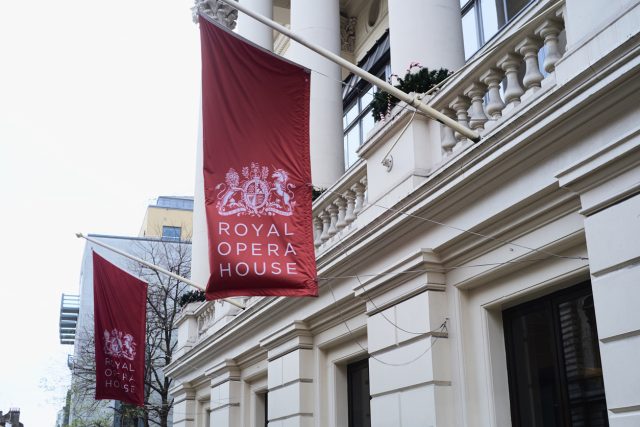Wine and opera have long shared a stage — sometimes in harmony, sometimes in parallel. Now they meet again, in an online auction for a good cause, writes James Bayley.

At Christie’s this month, 130 lots of fine and rare wines are up for grabs — everything from grower Champagne and Bordeaux First Growths to cult Napa Cabernets and Tokaji.
The collection, amassed by a benefactor of the Royal Opera House, is being
sold online to raise funds for the Royal Ballet & Opera Schools’ national outreach.
The wines themselves are serious, but the tone of the sale is not overly solemn. As wine specialist and auctioneer Charles Foley told
db, “We are happy to help support the charitable outreach of the Royal Opera House with the sale of this fabulous cellar of fine wines from across the world.”
Wine in the wings
The association between opera and wine is not a new invention, nor is it particularly tidy. The two have long shared a cultural table — sometimes quite literally. At Covent Garden, wine has been served in and around the Royal Opera House since its Victorian heyday, when gentlemen in box seats dispatched footmen for glasses of sherry, and the Crush Room earned its name from the aristocratic scrum gathering there during intermission.
According to
Time, the reopening night of 1999 saw crowds in the Paul Hamlyn Hall that resembled “a huge 19th-century painting come to life,” with patrons toasting under the glass vaults of the former flower market. A Champagne bar — later sponsored by Perrier-Jouët — was installed not far from the grand staircase, just in case the opera itself didn’t provide enough fizz.
Yet if wine was once a signifier of social class and cultural capital, it’s now more of a shared ritual — a glass in hand being less about status and more about coping with a four-hour Wagner. The Royal Opera House has leaned into that soft glamour, offering everything from Veuve Clicquot to English sparkling by Chapel Down, and even launching its own house red, white and rosé.
The collection: serious wines, less serious mood
The collection now on offer via Christie’s is the product of a private donor who, we are told, had an affection for both opera and fine wine — an intersection not uncommon, though rarely so well catalogued. “The benefactor is a supporter of The Royal Opera House with a love of Opera and Ballet and also fine wines,” said Foley. “They have collected an enviable cellar, running the gamut from grower Champagne such as Selosse... to cult Napa Cabernets such as Promontory.”
Unlike many private collectors who stick to
Bordeaux and Burgundy with the loyalty of a Met Opera subscriber to Puccini, this donor cast a wider net. There are appearances from Australia’s Henschke and Penfolds, Germany’s J.J. Prüm, California’s Au Bon Climat, Hungary’s Royal Tokaji and Italy’s Conterno.
“It is a true wine lover’s cellar and shows both academic interest in wine alongside hedonistic pleasure in the bottles,” Foley said.
Beyond the interval drink
The intersection of wine and opera doesn’t require overstatement — but it does persist, in both high drama and quiet habit. Whether in Verdi’s
La Traviata (with its famous brindisi) or the modest clink of glasses during a Royal Opera House interval, wine plays its part.
This goes all the way back to ancient Greece, where theatrical performance was born of Dionysian ritual. In that light, the idea of modern audiences sipping a Sancerre before the second act feels less indulgent and more traditional — even participatory.
The Christie’s sale, then, fits this pattern: wine playing a supporting role in the cultural experience, helping to keep the arts — literally and figuratively — on their feet.
The current sale is relatively understated. No tuxedos required. Just an internet connection and a bidding paddle, with the proceeds supporting arts outreach — including events in schools across Thurrock, Rotherham and Bradford.
In the end, this isn’t about placing wine and opera on some shared pedestal. There’s nothing wrong with a good bottle of Latour, after all. And there’s certainly nothing wrong with buying it to help more people access a world-class performance — even if your only interval tradition is a glass of English fizz and a packet of crisps.

 At Christie’s this month, 130 lots of fine and rare wines are up for grabs — everything from grower Champagne and Bordeaux First Growths to cult Napa Cabernets and Tokaji.
The collection, amassed by a benefactor of the Royal Opera House, is being sold online to raise funds for the Royal Ballet & Opera Schools’ national outreach.
The wines themselves are serious, but the tone of the sale is not overly solemn. As wine specialist and auctioneer Charles Foley told db, “We are happy to help support the charitable outreach of the Royal Opera House with the sale of this fabulous cellar of fine wines from across the world.”
At Christie’s this month, 130 lots of fine and rare wines are up for grabs — everything from grower Champagne and Bordeaux First Growths to cult Napa Cabernets and Tokaji.
The collection, amassed by a benefactor of the Royal Opera House, is being sold online to raise funds for the Royal Ballet & Opera Schools’ national outreach.
The wines themselves are serious, but the tone of the sale is not overly solemn. As wine specialist and auctioneer Charles Foley told db, “We are happy to help support the charitable outreach of the Royal Opera House with the sale of this fabulous cellar of fine wines from across the world.”










































































































































































